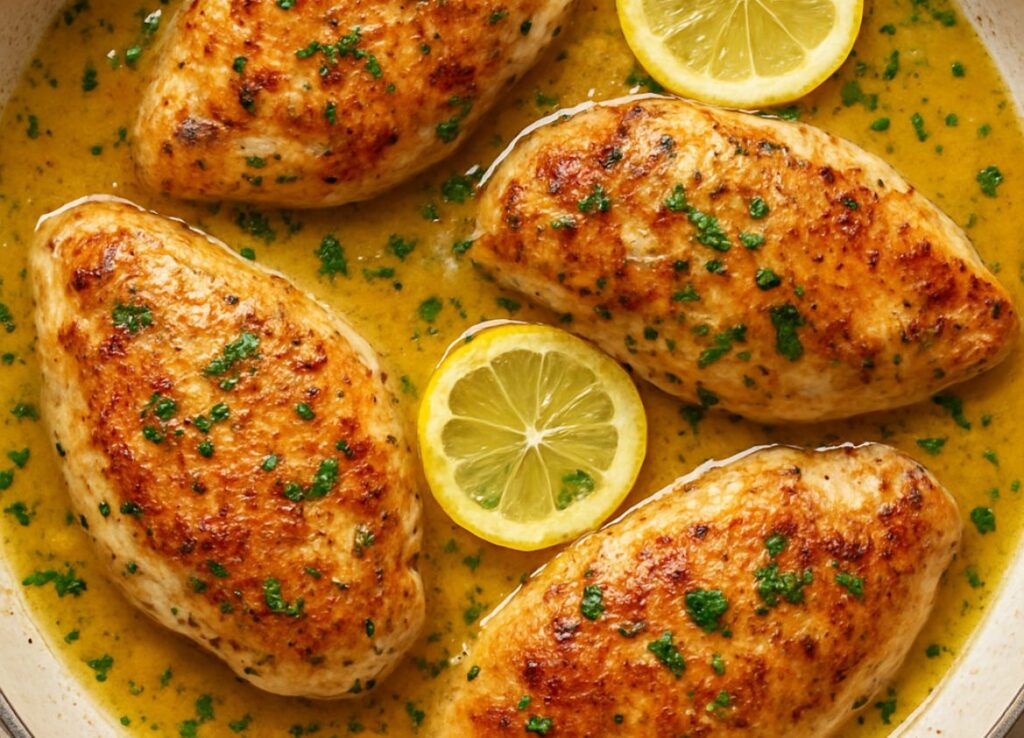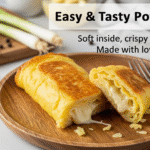The Best Fluffy Pancakes recipe you will fall in love with. Full of tips and tricks to help you make the best pancakes.
Garlic Butter Lemon Chicken is one of those dishes that feels simple yet delivers big on flavor. You get tender chicken with a golden crust, coated in a bright lemon butter sauce that balances richness with freshness. It’s quick enough for a weeknight but satisfying enough to serve when you want something a little more special.

I like how the garlic and lemon work together to cut through the buttery sauce, giving every bite a clean finish. The chicken stays juicy, and the sauce clings to it in just the right way. You can even pair it with creamy parmesan pasta for a fuller meal that doesn’t take much extra effort.
What makes this recipe even better is how flexible it is. You can swap in different vegetables, adjust the seasoning to your taste, and store leftovers without losing flavor. That’s why I keep coming back to this dish—it’s easy, reliable, and always enjoyable.
Essentials of Garlic Butter Lemon Chicken
I focus on three main factors when making garlic butter lemon chicken: the ingredients that build flavor, the type of chicken cut I choose, and the way lemon, garlic, and butter balance each other. Each of these details changes the taste, texture, and final result on the plate.
Key Ingredients and Their Roles
| Ingredient | Recommended Amount |
|---|---|
| Chicken breasts (or thighs) | About 4 breasts (~1 lb) |
| Salt & pepper | To taste |
| Flour or parmesan (optional) | For light coating |
| Olive oil or butter | 1–2 tbsp for cooking |
| Garlic | 2–3 cloves, minced |
| Butter | 2–4 tbsp, divided |
| Lemon juice (fresh) | 2–3 tbsp |
| Chicken broth (optional) | ½ cup (for sauce lift) |
| Italian seasoning, parsley, red pepper flakes (optional) | For extra flavor |
I rely on a few core ingredients to create depth. Garlic cloves add sharp, savory notes, while butter softens that bite with richness. I prefer unsalted butter so I can control the salt level.
I use fresh lemon juice for brightness and sometimes add lemon zest for more concentrated citrus flavor. Olive oil helps sear the chicken evenly without burning the butter.
Seasonings also matter. A mix of paprika, garlic powder, and Italian seasoning gives the chicken color and subtle herbal tones. A pinch of red pepper flakes can add gentle heat. Salt and black pepper round everything out.
I find that balancing these ingredients makes the sauce both flavorful and versatile for pairing with rice, pasta, or vegetables.
Step-by-Step Instructions
- Prep the chicken
- Pound chicken to even thickness.
- Season with salt and pepper; dredge lightly in flour or parmesan if you want a light crust.
- Sear the chicken
- Heat oil or butter in a skillet over medium-high heat.
- Cook chicken 4–5 minutes per side until golden brown and fully cooked.
- Remove chicken and keep warm.
- Make the lemon butter sauce
- Add garlic to the same pan, sauté for 30 seconds.
- Deglaze with chicken broth or water, scraping the browned bits.
- Stir in lemon juice, simmer to reduce slightly.
- Lower heat and whisk in butter until melted and glossy.
- Combine and finish
- Return chicken to skillet and spoon sauce over the top.
- Garnish with parsley and fresh lemon slices.
- Serve immediately
- Plate with sides like mashed potatoes, roasted veggies, or rice.
Tips & Variations
- Use chicken thighs for juiciness
- Make it gluten-free: use cornstarch instead of flour
- Add veggies: sauté zucchini, green beans, or asparagus in the same skillet
- Boost flavor: add white wine or parmesan to the sauce
- Meal prep friendly: reheat gently with a splash of broth and fresh lemon
Nutritional Information (Per Serving, Approximate)
- Calories: ~350
- Protein: ~28g
- Carbs: ~4g (if lightly floured)
- Fat: ~24g
- Fiber: <1g
- Sodium: ~450mg (depending on seasoning)
Choosing the Best Chicken Cuts
The cut of chicken changes the dish’s texture and cooking time. I often use chicken breasts because they cook quickly and stay lean. Pounding them to even thickness ensures they sear evenly.
When I want more flavor, I use chicken thighs. They have higher fat content, which makes them juicier and more forgiving if cooked a few minutes longer. Boneless, skinless thighs are easiest to work with, while bone-in cuts give extra flavor but require more cooking time.
Here’s how I decide:
| Cut | Texture | Flavor | Cooking Time |
|---|---|---|---|
| Chicken Breast | Lean, tender | Mild | Faster |
| Chicken Thigh | Juicy, rich | Stronger | Slightly longer |
Both cuts work well, but I adjust seasoning amounts and cooking time to match the cut I choose.
Flavor Profile-Garlic, Butter, and Lemon
The main flavors come from three ingredients working together. Garlic brings a strong, savory base that deepens as it cooks. I use fresh garlic for the best taste, but garlic powder can add extra background flavor.
Butter adds creaminess and helps carry the garlic’s aroma. When combined with the pan’s browned bits, it creates a smooth sauce that coats the chicken.
Lemon juice cuts through the richness and keeps the dish light. I sometimes add zest for stronger citrus notes. The balance is key—too much lemon can overpower, while too little leaves the sauce heavy.
When seasoned with salt, pepper, and optional red pepper flakes, the three flavors create a sauce that feels bright yet savory, making the chicken both tender and flavorful.
Step-by-Step Cooking Method
I focus on getting the chicken well-seasoned, building a flavorful lemon garlic butter sauce, and cooking it in a way that keeps the meat tender and juicy. Small details like drying the chicken, controlling heat, and balancing lemon with butter make the difference in this chicken recipe.
Preparing and Seasoning the Chicken
I start by patting the chicken breasts dry with paper towels. Removing excess moisture helps them brown evenly and prevents steaming in the pan.
Next, I season both sides with salt, black pepper, and a touch of thyme. This simple mix creates a solid base for the lemon garlic butter chicken. If I want more depth, I sometimes add paprika for color or red pepper flakes for a mild kick.
I also trim any thick pieces so the chicken cooks evenly. If the breasts are large, I slice them in half horizontally to make cutlets. This keeps cooking time shorter and helps me avoid dry meat.
For extra flavor, I occasionally marinate the chicken in lemon juice and garlic for 30 minutes. This step isn’t required, but it can enhance the final taste.
Making the Lemon Garlic Butter Sauce
I melt butter in a skillet over medium heat until it begins to bubble. Then I add minced garlic and stir for about a minute. Garlic burns quickly, so I keep it moving to release its aroma without turning bitter.
Once the garlic softens, I pour in fresh lemon juice and scrape the pan to loosen any browned bits. This deglazing step adds depth to the sauce and ties the flavors together.
To finish, I whisk in more butter and a pinch of thyme. The result is a smooth lemon garlic butter sauce that balances brightness from the lemon with richness from the butter.
If I want a lighter version, I replace part of the butter with olive oil. For a creamier texture, I stir in a splash of cream at the end.
Cooking Techniques for Tender Chicken
I sear the chicken in the skillet with melted butter until golden brown on each side. The key is not to overcrowd the pan, so I cook in batches if needed.
I check doneness with a thermometer. The internal temperature should reach 165°F (74°C) for safe and tender chicken. Overcooking makes the meat dry, so I remove it as soon as it hits the right temperature.
After cooking, I return the chicken to the skillet with the sauce. I spoon the garlic butter sauce over the top and let it simmer for 1–2 minutes. This step coats the chicken evenly and locks in flavor.
For serving, I garnish with chopped parsley and lemon wedges. This adds freshness and a clean finish to the dish, as shown in this lemon garlic butter chicken recipe.
Creamy Parmesan Pasta Pairings
I focus on building a smooth Parmesan sauce, choosing pasta that holds flavor well, and bringing the chicken and pasta together in a balanced way. Simple steps like saving pasta water or using freshly grated cheese make a noticeable difference in both texture and taste.
Creating the Parmesan Sauce
I start with a base of butter and heavy cream, then slowly whisk in freshly grated Parmesan cheese. Using freshly grated cheese instead of pre-shredded avoids clumps and creates a smoother sauce.
I keep the heat low while stirring so the cream doesn’t separate. A pinch of garlic powder or minced garlic adds depth without overpowering the Parmesan.
If the sauce feels too thick, I loosen it with a spoonful of reserved pasta water. This starchy liquid helps bind the sauce to the pasta, giving it a silky finish.
I also season lightly with salt and pepper, but I taste as I go since Parmesan already adds a salty flavor.
Best Pasta Choices and Cooking Tips
I find that linguine works especially well because its flat shape holds the creamy sauce. Fettuccine and spaghetti are also good options, while short pasta like penne offers a different texture.
For gluten-free needs, I use gluten-free pasta made from rice or corn, but I check the cooking time carefully since it softens faster than wheat pasta.
I always salt the water generously before boiling. This seasons the pasta from within, which makes the whole dish taste better.
Cooking until al dente is important because the pasta will continue to cook slightly when tossed with the hot sauce.
Combining Chicken and Pasta for Serving
Once the creamy Parmesan pasta is ready, I toss it gently in the sauce, adding more pasta water if needed to coat evenly.
I layer the garlic butter lemon chicken on top rather than mixing it all in at once. This keeps the chicken’s seared edges intact and prevents the sauce from becoming greasy.
For plating, I garnish with fresh parsley and an extra sprinkle of grated Parmesan cheese. This adds freshness and a final touch of flavor.
If I want a lighter balance, I serve the pasta with a side of steamed vegetables or a crisp salad. For a richer meal, I double the sauce and let the pasta absorb more creaminess.
For a reliable recipe that combines these steps, I often look to lemon garlic butter chicken with creamy Parmesan pasta, which shows how well the chicken and pasta come together in one dish.
Customizations, Serving, and Storage
I often change this dish to fit what I have on hand, and it works well for both quick weeknight dinners and more comforting meals. Small adjustments in ingredients, plating, and storage can make the chicken more flavorful, practical, and easy to enjoy later.
Ingredient Variations and Substitutions
I like using chicken thighs for richer flavor, but chicken breasts also work if I want a leaner option. If I use breasts, I pound them to an even thickness so they cook evenly.
For the butter, I sometimes swap half with olive oil to lighten the dish. Garlic can be fresh, roasted, or even garlic paste if I need to save time. Lemon juice is best fresh, but bottled juice works in a pinch.
If I want a creamier texture, I stir in a splash of heavy cream or a spoonful of cream cheese. To add more depth, I mix in parmesan, similar to this skillet garlic lemon butter chicken recipe.
For herbs, fresh parsley adds a bright finish, but thyme, rosemary, or basil are also good choices. I sometimes add red pepper flakes for a mild kick.
Serving Suggestions and Garnishes
I usually serve the chicken with rice, pasta, or roasted potatoes to soak up the lemon butter sauce. Steamed green beans or broccoli balance the richness with freshness.
For a lighter meal, I pair it with a simple side salad dressed with olive oil and lemon. If I want a more filling comfort food plate, I add creamy mashed potatoes.
I garnish with fresh parsley for color and freshness. A few lemon slices or wedges work well for presentation and extra acidity. If I’m serving guests, I place the chicken in a shallow bowl so the sauce pools around it, making it easy to spoon over sides.
Storing and Reheating Leftovers
I keep leftovers in an airtight container in the refrigerator for up to 3 days. For longer storage, I freeze portions for about 2 months. Freezing works best if I separate the chicken from any vegetables so textures don’t soften too much.
When reheating, I prefer the stovetop over the microwave. I warm the chicken gently in a skillet with a splash of chicken broth or water to keep it moist.
If I reheat from frozen, I thaw it overnight in the fridge first. This helps the sauce stay smooth and prevents the chicken from drying out. For quick meals, I portion the chicken into single servings before freezing so I can defrost only what I need.




